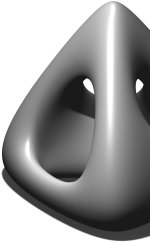Subdivision Methods for Modelling
Neil Dodgson, Malcolm Sabin, Jiří Kosinka, Dongjoe Shin
The Rainbow Group at the Cambridge Computer Laboratory has been working on subdivision since 2000. Dr Malcolm Sabin has, of course, been working on them for considerably longer, being one of the founders of the field.
The group has published over thirty papers in various aspects of subdivision: NURBS-compatible subdivision, tuned subdivision, classification of subdivision schemes, analysis of new schemes, considerations of continuity, tutorials and surveys.
Subdivision surfaces and NURBS are alternative mechanisms for representing 3D shapes. Both were developed in the 1970s. NURBS quickly became the industry standard in computer-aided design (CAD). Subdivision was not practicable until the late 1990s, owing to its large memory requirement. When sufficient memory became available, it was rapidly adopted by the computer animation industry, owing to the ease of design it allows, and is essentially the standard tool there today. The CAD industry has not adopted subdivision, partly because it is not fully compatible with their existing NURBS paradigm, and partly because subdivision introduces a number of artefacts that are irrelevant when making images to view on a movie screen, but which are critical when machining parts in the real world. My research group has successfully addressed these problems.

Our most significant recent result, published at SIGGRAPH 2009, is in creating a subdivision method that is a true super-set of NURBS, something that had not been done in the thirty years since subdivision was invented. This was a major breakthrough. We continue to work on the problem with the hope that it will allow CAD vendors to incorporate subdivision into their systems, with all its benefits, without having to throw away any of their existing surface models or processes.
- “NURBS with extraordinary points: high-degree non-uniform subdivision surfaces”, T. J. Cashman, U. H. Augsdörfer, N. A. Dodgson, and M. A. Sabin, ACM Transactions on Graphics 28(3):Article 46 (9pp), Aug 2009 (Proc. SIGGRAPH 2009) — Project page (includes preprint, video, code)
- “Selective knot insertion for symmetric, non-uniform refine and smooth B-spline subdivision”, T. J. Cashman, N. A. Dodgson, and M. A. Sabin, Computer Aided Geometric Design, 26(4):472–479, May 2009 — [Preprint also available]
Amongst other results, we have successfully developed methods that improve the behaviour and the look of the standard subdivision methods and have analysed the underlying behaviour of subdivision in various ways.
- “Tuning subdivision by minimising Gaussian curvature variation near extraordinary vertices”, U. H. Augsdörfer, N. A. Dodgson, and M. A. Sabin, Computer Graphics Forum 25(3):263–272, (Proc. Eurographics 2006)
- “On the support of recursive subdivision”, I. P. Ivrissimtzis, M. A. Sabin, and N. A. Dodgson, ACM Transactions on Graphics, 23(4):1043–1060, Oct 2004
The group’s work has been funded by the EPSRC since 2004, through three separate grants (2004–07, 2007–11, 2011-2014). Previously, the group’s work was funded by the European Union MINGLE project (multiresolution in geometric modelling). Six research associates on that project worked at Cambridge:
- Loïc Barthe (who went on to work with Leif Kobbelt at RWTH in Aachen for a year, and is now lecturing in Toulouse)
- Ioannis Ivrissimtzis (who went on to work with Hans-Peter Seidel at the Max-Planck Institute in Saarbrücken and is now at Durham University)
- Mo Hassan (who worked for six months at the Max-Planck Institute in Saarbrücken and then completed his PhD here)
- Cédric Gérot (who is now lecturing in Grenoble)
- Lucia Romani
- Saulius Narkevicius
